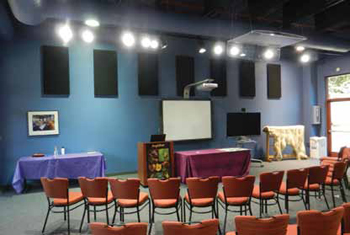Primacoustic panels improved acoustics and intelligibility for the distance learning programs at the Memphis Zoo.MEMPHIS, TN—At the end of 2011, the Memphis Zoo transformed its Discovery Center building into a distance learning facility, using funds awarded for the purpose by the United States Department of Agriculture (US DA). The Dotty Griscom Distance Learning Laboratory (DGDLL) is used by the zoo’s Education Department and other departments as a classroom and meeting space, and is also available for meetings by corporations and government entities.
The Memphis Zoo received a $500,000 grant under the Distance Learning and Telemedicine Grant Program administered by the Rural Utilities Service in 2011, which the zoo’s Education Department applied toward a nanotechnology program, dubbed “NanoZoo Connects.” According to a statement from the zoo, the program was designed to initially reach approximately 7,000 students in 14 rural Tennessee schools through distance learning technology. The grant allowed the zoo to outfit a distance learning studio as well as a large classroom at the DGDLL.
“NanoZoo and distance learning bring the Memphis Zoo on the cutting edge of technology,” said Chuck Brady, president and CEO of the Memphis Zoo. “What we learn in the early stages of these initiatives will revolutionize the way we are able to help educate students in Tennessee and, one day, across the globe.”
According to Larry T. Robinson, head of technology and distance learning at the Memphis Zoo, the large classroom seats approximately 100 people, with space for a further 50 seated at tables. “We have three flat panel screens, a Promethean board, and a Tandberg standard-def unit for distance learning,” he said. “We’ve just integrated the Apple TV products because we’re integrating iPads into our classes. So we can do ‘keeper chats’ and things like that around the zoo and broadcast them directly into the classroom.”
Audio playback is via a FrontRow Pro Digital system, with wall speakers and IR sensors. A ceiling-mounted Tandberg AudioScience pressure zone microphone kit with fiberglass boundary assembly picks up the audience while a second mic is available at the podium or at a desk, said Robinson, who worked with Michael Lay, education sales consultant at PCS, a Cisco reseller in Louisville, TN, that supplied and installed the equipment.
Memphis-based Running Pony Productions installed a video package in the production studio, which includes chroma key capabilities, two Tandberg PrecisionHD cameras, a pair of 46-inch flat panel Samsung televisions, and a NewTek Tricaster TCXD 300 HD production environment.
Unfortunately, however, the acoustics of the classroom left something to be desired, according to Robinson. “The room sounded as if you were in a hollow chamber and our transmissions, as reported by our DL partners, were unintelligible due to the overwhelming echo.”
It soon became apparent after a few meetings and DL transmissions in the newly renovated space that the room needed professional attention, he continued. “The room make-up is of sheetrock, metal, and glass. Therefore, we sought out a vendor who was accomplished at working with various room configurations and who had a reputation for solving difficult sound issues. Conference Technologies fit the bill.”
According to David Pierce, sales and design engineer at Conference Technologies’ Memphis office, acoustical problems in the room extended beyond unintelligibility. “Challenges with the space came from noisy transformers in the mercury vapor light fixtures and the HVAC system noise,” said Pierce. “We recommended that they replace the light fixtures and replace or just remove the air vents. They were small perforated metal vents much like speaker grills with small perforated holes which caused a whistling sound.”
To manage the reverberation and improve intelligibility, Pierce turned to Primacoustic, a division of Radial Engineering. “The Primacoutic panels reduced the noise level dramatically,” said Pierce. “We used Primacoustic’s two-inch-thick, two-foot by four-foot baffles; 23 were wall-mounted around the perimeter and 28 were suspended vertically from the ceiling.”
Steve Harvey (psnpost@nbmedia.com) has been west coast editor for Pro Sound News since 2000 and also contributes to TV Technology and Pro Audio Review. He has 30 years of hands-on experience with a wide range of audio production technologies.
